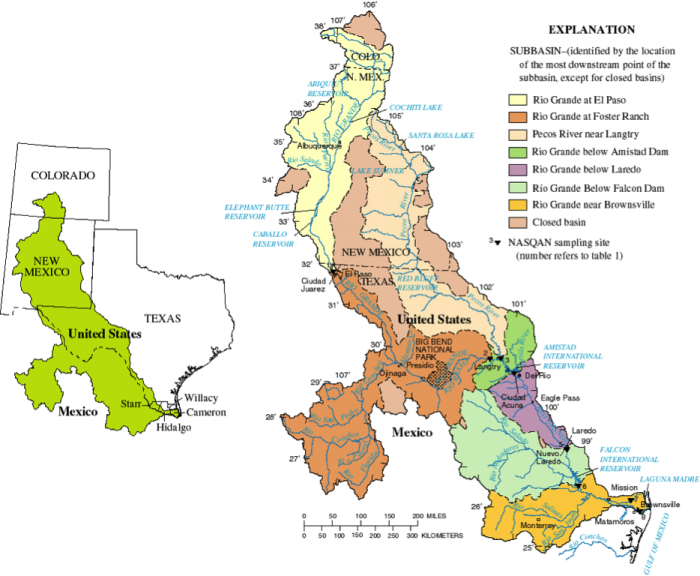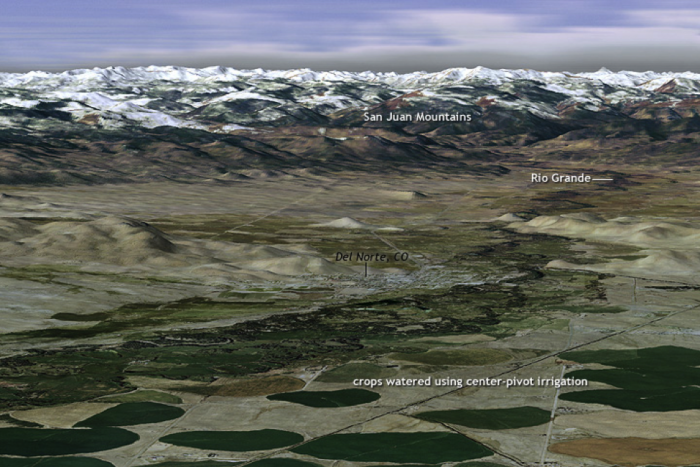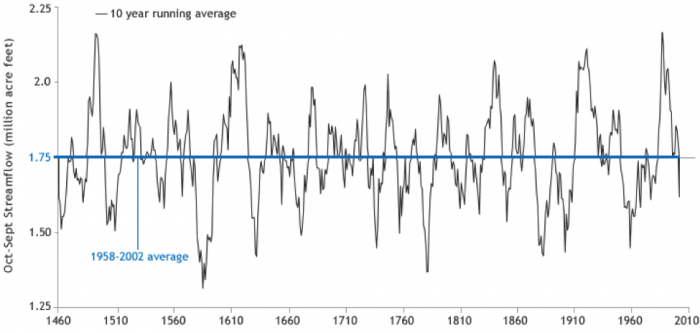The Rio Grande
The Rio Grande River flows along the U.S. (Texas)-Mexico border for nearly 1,248 miles (2,008 km) including meanders. Although snowmelt from the San Juan Mountains of Colorado (Fig. 7) is a major source of water for the Rio Grande, runoff from northern Mexico also contributes to its flow. As in all arid to semiarid regions, the waters of the Rio Grande River are highly sought after and overallocated. And, as in the case of the Colorado River, the water division between the U.S. and Mexico is regulated by Treaty (see below).
Rio Grande River water is in demand because of the intense agriculture in New Mexico-Texas (Fig. 8) as well as in northern Mexico. This water supply deficit has been exacerbated by prolonged drought in the southwest. Figure 9 is a long-term record of flow of the Rio Grande River (at Otowi Bridge) reconstructed by tree ring records calibrated to more modern flows (see TreeFlow). Note the frequent cycles of surfeit and drought, and the most recent steadily decreasing flow trend beginning about 1990.

In all, there are 15 dams on the Rio Grande River, many of them in New Mexico. Flows are significant until Elephant Butte Reservoir in New Mexico. El Paso, TX is 125 river miles downstream of Elephant Butte Reservoir and just upstream of the American Dam. Releases from Elephant Butte Reservoir control streamflow to El Paso. At American Dam, much of the flow in the Rio Grande is diverted for irrigation and municipal uses in Texas and Mexico. From the American Dam, the Rio Grande has little or no flow until joined by the Río Conchos about 300 miles downriver, which originates in the Sierra Madre Occidental in Mexico (see below). The Pecos River, a major U.S. tributary, joins the Rio Grande another 300 miles or so downriver near Langtry, TX (Fig. 7); the Pecos flow is also controlled by a dam upstream from its confluence with the Rio Grande. Further downriver, the flows in the Rio Grande River decrease significantly as the result of withdrawal for agricultural and municipal use in southwest Texas as well as the relatively low influx of water from tributaries. In Some years, the Rio Grande flow does not even make it to the sea near Brownsville, TX.


About 75% of water withdrawals from the Rio Grande River are in support of agriculture. Population growth has also been a factor, particularly in Mexico, where the population has nearly doubled since 2005, and nearly 6 million people depend on the Rio Grande River and related groundwater basins for drinking water. The U.S.-Mexico Treaty of 1848 established the international boundary, modified slightly by later "Conventions." The Treaty of 1944 between the two countries partitioned water from the Rio Grande River along the Texas-Mexico Border (as well as stipulating Colorado River flows to Mexico, see above), modified slightly by a 1970 Treaty, and authorized both countries to construct, operate, and maintain dams on the main channel of the Rio Grande. The International Boundary and Water Commission (IBWC) was assigned the task of dealing with water quality issues along the international border.
According to the Treaty of 1944, the U.S. is entitled to about one-third of the flow of the Rio Conchos from Mexico, which amounts to about 350,000 acre-ft/y on average. By the Treaty, Mexico is obligated to release 1.5 million acre-ft over a five-year period. During times of drought, it is difficult to meet the annual expectation, and, typically, Mexico releases more water in good rainfall-runoff years and conserves during drought periods, although at one point Mexico did not meet their obligation for nearly ten years. This pattern makes it difficult for agriculture in southwest Texas because water resources cannot be adequately predicted, and, in 2013, a controversy erupted between Texas and Mexico because of long-term drought that peaked in 2011 (Texas Observer: On the Border, a Struggle over Water) --another example of the difficulties of sharing even major rivers.
